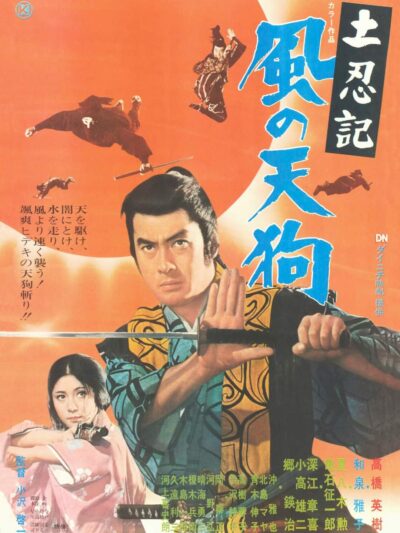 This 1970 Nikkatsu release is allegedly “the most gory ninja film of its era.” HAUNTED SAMURAI (KAZE NO TENGU) is also one of the most obscure ninja films of its era, having been all-but impossible to find prior to 2023, when it was given a limited edition Blu-ray release by Diabolik DVD. It was adapted from the 1967 manga DONINKI by Goseki Kojima, the illustrator of the iconic LONE WOLF AND CUB manga, which explains why the film plays so much like the LONE WOLF film series (and SHOGUN ASSASSIN compilation feature), although HAUNTED SAMURAI actually preceded its first entry by two years.
This 1970 Nikkatsu release is allegedly “the most gory ninja film of its era.” HAUNTED SAMURAI (KAZE NO TENGU) is also one of the most obscure ninja films of its era, having been all-but impossible to find prior to 2023, when it was given a limited edition Blu-ray release by Diabolik DVD. It was adapted from the 1967 manga DONINKI by Goseki Kojima, the illustrator of the iconic LONE WOLF AND CUB manga, which explains why the film plays so much like the LONE WOLF film series (and SHOGUN ASSASSIN compilation feature), although HAUNTED SAMURAI actually preceded its first entry by two years.
Rokuheita Kusanagi (Hideki Takahashi) is a samurai enforcer for the Yagyu ninja clan. He’s a staunch upholder of the code of the samurai, but Rokuheita’s sister doesn’t agree with it, and, after witnessing her sibling brutally massacre a foe, hangs herself in protest. This causes a crisis of conscience in Rokuheita, which culminates when he refrains from killing a deserter, electing instead to become a fugitive—and in so doing learns the meaning of the phrase “There is no peace for those who desert.”
After attempting to help a young woman who lures him into a seaside trap involving an army of topless babes—which he easily bests—Rokuheita enters a drought-stricken village. Here he aims to live out the remainder of his life as a farmer. The village, however, is infested with Yagyu adherents, among them Matahei Tarao (Seiichirô Kameishi), an ex-samurai banished from his post for stealing. Tarao tries to off Rokuheita—and so curry favor with his former overlords—by enlisting his seductive wife to use her feminine wiles. The gambit fails and the tension builds, culminating in a climactic mano-a-mano that takes place during a solar eclipse (which doesn’t stop the proceedings from being extremely well lit).
HAUNTED SAMURAI can be viewed as the stylistic forerunner of the aforementioned LONE WOLF AND CUB (1972-74) and LADY SNOWBLOOD (1973-74) film cycles. The conventions of those films—swords making exaggerated swishing sounds when hefted and hissing noises when they pierce flesh, arterial geysers, etc.—are very much present (albeit in muted form) in HAUNTED SAMURAI.
It’s beautifully lensed by cinematographer Minoru Yokoyama, with highly formal, art film-redolent blocking. Those things, however, don’t forgive the poor storytelling. The film is packed with arbitrary, and often downright puzzling, plot points (such as the inexplicable hiding of a bag of gold dust in a river) that even the trash film historians Chris Pologgi and John Charles, who do the Blu-ray audio commentary, can’t logically explain.
The film’s biggest problem is that its best scene, a dreamlike underwater sword fight, occurs seventeen minutes in. This causes the proceedings to peak early, as nothing else comes close to matching that early sequence in innovation or excitement. So in the category of 1970s Japanese samurai/ninja cinema HAUNTED SAMURAI is far from exceptional, but it’s definitely above average.
Vital Statistics
HAUNTED SAMURAI (KAZE NO TENGU; SHINOBI DEMON: DUEL IN THE WIND)
Nikkatsu
Director: Keiichi Ozawa
Screenplay: Selli Hoshikawa
(Based on manga by Goseki Kojima)
Cinematography: Minoru Yokoyama
Editing: Shinya Inoue
Cast: Hideki Takahashi, Masako Izumi, Isao Natsuyagi, Seiichirô Kameishi, Shôki Fukae, Yuji Kodaka, Eiji Gô, Masaya Oka, Utako Shibusawa, Maya Kitajima
